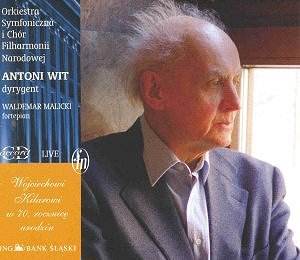Kilar
is one of the least forbidding faces
of modern Polish music compared, for
example, with Pavel
Szymanski another face from the
CD Accord catalogue. He has some of
the gestures and armoury of the ivory
tower avant-garde but his inclinations
are keyed into appreciation by a discriminating
wider audience. Melody plays a crucial
part in his music and it rises from
dissonance to sing free in many of his
scores. Make no mistake though; he is
not a Malcolm Arnold in his writing
nor a late late-romantic like George
Lloyd.
Over
the years, from the late forties to
the mid-seventies, his populist tendencies
gave him exposure in Poland and the
Soviet bloc but denied him worldwide
acceptance. Compare his fate with that
of his countrymen Penderecki and Lutosławski.
It is only from the late seventies that
a trickle of recordings has reached
the wider body of music-lovers. I recall
a Jerusalem LP of his Krzesany
making some international headway but
little else.
Koscielec
has many memorable incidents.
The passion of the massed strings at
5.32, the screaming and steaming trumpet
at 10.40 meet the grandeur of big string
theme with all the dignity of a hymnal.
This is just a step distant from the
epic paeans of Roy Harris at one axis
and Panufnik at the other. The steady
ascent at 12.02 onwards recalls the
thunderously long-breathed Howard Hanson
Sixth Symphony. I have mentioned several
names but you can also relate his incident-rich,
sombre and strange approach to Messiaen
(e.g. the bird whirring and whirling
at 13.20), to Valentin Silvestrov and
Avet Terteryan. This is music pregnant
with tension and threatening magic.
The
Piano Concerto opens with a slow
and very quiet iterative six-note piano
cell-pulse over long-held notes from
the violins. This is blessedly simple
stuff gripping the listener's attention
and likely to be very acceptable for
those who do not have an aversion to
the slow evolutionary gait of minimalism.
Its effect is like watching flowers
bloom in slow motion. Be warned … or
encouraged … there is less incident
in this concerto than in Koscielec.
This might serve aptly as a Polish companion
to Nyman's Piano Concerto. The first
movement rises to a tense eminence associated
with the iterative pulse then relaxes
at 6.20 and continues its whispering
repeated peal of piano notes. The violins
are tense in their vulnerable transition
between silence and sound and can again
be likened to the healing spirit to
be found in Panufnik - e.g. in his own
piano concerto (also on Accord played
by Ewa Poblocka) and Sinfonia Elegiaca.
The second movement has the same quiet
spirituality but here it is more closely
related to Slavonic chant rising at
the close to a tautly assertive pulsing
figure for strings and piano mezzo
forte. This pitches without pause
into the finale which sees the first
surging tumultuous pacing. Fast and
repetitive, almost jazzy, the piano
races along with hammering repetitions
and gruff rhythmic, insistent work from
brass and strings. There are echoes
here of the vertiginous Bartók
and Stravinsky though the 'coating'
and manner is sweeter.
Bogurodzica
(the ancient hymn of Polish
chivalry) is the first of two works
that deploy orchestra with choir. It
starts with a rising and intimidating
wave of side-drum 'shots'. This same
wave winds the work down into a niente
at the close. The choral writing
seethes with dissonance seemingly influenced
by the Polish school of the 1960s. As
in parts of Koscielec and the
Piano Concerto there are also moments
of unruffled quasi-mystic calm (7.55).
Kilar's
Exodus has a bifurcated
root: on the one hand Ravel's Bolero
and on the other the Israelites' hymn
of thanks at having crossed the Red
Sea. As the candid notes point out,
the Kilar theme is shorter than the
Bolero cell. The harp 'ticks'
repeatedly, satisfied and stilling while
the clarinet sings a short swaying figure
that sounds Middle-Eastern. Like Bolero
the interest (or aggravation) lies in
the ringing of orchestral colour changes.
As with the first two movements of the
Piano Concerto this work speaks peace
unto nations. The pulse quickens and
develops a more triumphant accent (12.51)
and an impetuous vitality. This coasts
restfully down to where the string sonorities
dominate (something like RVW's Concerto
Grosso) before returning to the
barbaric triumphs we associate with
Rozsa's Biblical epics and Hans Zimmer's
Gladiator music for imperial
Rome. Three minutes short of the end
the choir repetitively rap out their
'warning' and recede into a minatory
whisper-patter (20.54) reminiscent of
Orff in Carmina Burana. This
then rises to jubilant singing in which
the strings sing the swaying theme and
the brass and percussion blast out the
ostinato. The choir's voices ring with
invocational praise and a final cloud
of aleatoric chatter flickers over a
thudding ostinato.
Was
it all of thirty years ago that sitting
in a basement flat in Paignton I was
introduced to Kilar's gorgeous Krzesany?
Now not only do we have the superb Naxos
collection of Kilar (warmly welcomed
elsewhere on this site) but also this
live concert in which a far from feeble
Kilar celebrates his seventieth birthday.
Rob
Barnett
The
entire CDAccord catalogue is available
from MusicWeb

![]() for
details
for
details